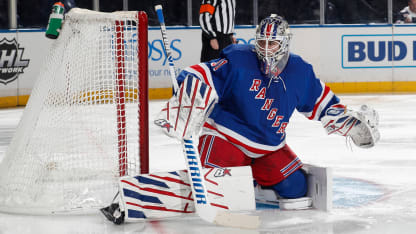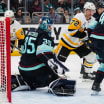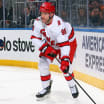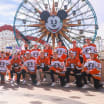Unmasked: Shesterkin making case for Hart Trophy
Rangers goalie would be ninth at position to win award as NHL MVP

© Jared Silber/Getty Images
Henrik Lundqvist, the man Shesterkin followed as the New York Rangers No. 1, won the Vezina Trophy as the NHL's best goalie in 2011-12 and finished third in Hart Trophy voting behind Evgeni Malkin of the Pittsburgh Penguins and Steven Stamkos of the Tampa Bay Lightning.
Lundqvist had his number retired by the Rangers on Jan. 28 after playing 15 seasons for New York. Now, a part-time studio analyst on Rangers broadcasts on MSG Network, he has no problem with goalies being MVP candidates.
"Yeah, why not?" Lundqvist said. "We have the goalie award (Vezina), obviously, but if a goalie means that much to a team, I think so."
Shesterkin clearly means a lot to the Rangers and has the credentials to be in the Hart Trophy conversation, which has been awarded since the 1923-24 season.
Although he allowed four goals on 17 shots and was pulled in a 6-2 loss to the St. Louis Blues on Thursday, the 26-year-old is 28-7-3 with a 2.02 goals-against average and .939 save percentage, each of which leads the NHL this season among goalies to play more than five games.
The Rangers are tied for 19th in goal scoring (2.91 goals per game), have given up tied for the ninth most shots per game (32.3) and rank 31st in shot-attempts percentage (45.2 percent), yet are tied for second in the Metropolitan Division and hold an 18-point cushion to make the Stanley Cup Playoffs.
- Chapters
- descriptions off, selected
- captions settings, opens captions settings dialog
- captions off, selected
This is a modal window.
Beginning of dialog window. Escape will cancel and close the window.
End of dialog window.
This is a modal window. This modal can be closed by pressing the Escape key or activating the close button.
NHL Tonight on Igor Shesterkin's case for the Hart
The Rangers (36-17-5) lead the NHL with 24 wins when being outshot by their opponent, five more than the second-place Nashville Predators. Shesterkin has been in goal for 20 of those victories.
"He's been so impressive to watch and he really plays a huge part in the Rangers success," Lundqvist said. "The numbers don't lie. He's so calm and I think the team feeds off that."
Those numbers include having a save percentage above .900 in 31 of his 38 appearances this season, the 81.6 percent rate the highest among NHL goalies who have played at least 10 games, and a barometer of his reliability.
"His consistency has been unbelievable," Lundqvist said.
Assessing Shesterkin's Hart Trophy candidacy beyond those numbers is tricky, in large part because it's difficult to compare goalies to skaters.
They may not play as many games as top scorers or elite defenders, but they do play more minutes and are often the more obvious difference between winning and losing.
So, how can the legitimacy of Shesterkin's bid be quantified?
One way is to compare his season to other goalies who have won the award, which is voted on by members of the Professional Hockey Writers Association.
Shesterkin has the fourth-best save percentage (.939) among goalies who have played at least 25 games since the NHL began recording shots in 1955-56.
Jacques Plante set the record (.944) for the Toronto Maple Leafs in 1970-71. Plante, who was 40 years old at the time, played 40 games that season.
So how does Shesterkin's save percentage compare to other goalies who won the Hart Trophy?
He has the highest differential among the Hart-winning goalies at .031 with the save percentage for the 2021-22 NHL season at .908.
Dominik Hasek is the closest comparable. He won the Hart with the Buffalo Sabres twice. In the 1996-97 season, Hasek had a .930 save percentage, which was .025 better than the NHL average (.905). The next season, he had a .932 save percentage, .026 better than the NHL average (.906).
Plante had a .017 percent difference during the 1961-62 season, and Carey Price of the Montreal Canadiens, the most recent goalie to win the Hart, had a .018 difference in the 2014-15 season (.933 to .915).
Al Rollins of the Chicago Black Hawks (1953-54, Chuck Rayner of the Rangers (1949-50) and Roy Worters of the New York Americans (1928-29) each won the Hart before shots were officially recorded by the NHL.
Shesterkin also has the biggest same-season gap between his save percentage and the next highest goalie, with a .009 lead on Ville Husso of the St. Louis Blues. Among goalies to play at least 25 games in a season, Hasek's .010 lead on Tom Barrasso in 1997-98 is the only margin in double digits.
The raw statistical measure where Shesterkin comes up short compared to the previous Hart Trophy-winning goalies is games played. Shesterkin has played 38 of the Rangers 58 games this season (66 percent), which puts him on pace for 54 games. Each of the goalies to win the Hart Trophy since the NHL went to an 82-game schedule in 1995-96 played at least 65 games.
Hasek played 72 games in 1997-98 and 67 the previous season. Jose Theodore played 67 in 2001-02 for the Canadiens and Price played 66 in 2014-15.
Of course, goalie usage has changed, with most teams using their backup more in recent seasons. There are only six goalies on pace to play 60 or more games this season.
When Hasek won his second consecutive Hart Trophy in 1997-98, there were 16 goalies to play 60 or more games. When Theodore won, 20 goalies played 60 or more. Seven years ago, when Price won, 12 goalies appeared in at least 60 games.
There is a possibility that Shesterkin will play more regularly in the final quarter of the season as the Rangers battle for position in the playoffs.
He missed eight games with a lower-body injury sustained Dec. 3, and another four games after being placed in NHL COVID-19 protocol in January.
As for the argument that skaters play in every game and are, as a result, more important or impactful than goalies, Shesterkin has played 2,196:22 this season, almost 700 minutes more than any position player, and he's doing it while posting historic numbers.
As Lundqvist said, that should be more than enough to warrant Hart Trophy consideration.

















